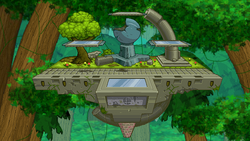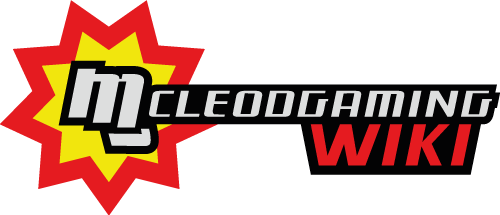(I hate to admit it, the rest of the stages that aren't in Beta must hold on for a while until it's come back.) |
mNo edit summary |
||
| Line 304: | Line 304: | ||
|} |
|} |
||
| − | ==== |
+ | ==== Disabled stages ==== |
{| class="wikitable sortable" |
{| class="wikitable sortable" |
||
! width="150" |Name |
! width="150" |Name |
||
Revision as of 18:17, 23 May 2019
- This article is about the areas in the Super Smash Flash series. For the more traditional area with a specific objective, see Level.

The Battlefield is an example of a typical stage in the Super Smash Flash series.
A stage (ステージ) is the designated area where characters fight each other in the Super Smash Flash series. Each stage has a different layout, size and shape, sometimes including hazards that affect the matches in some way, such as lava, water, explosions, etc. The word "stage" usually refers to a Group stage, but can also refer to the ground or large central platform within this location. Some stages, such as those in the various Stadium modes, exist for purposes other than fighting.
Group stages

The stage select in SSF2.
In both Super Smash Flash and Super Smash Flash 2, most of the versus mode stages are available from the start, while a small number must be unlocked by completing certain objectives. Most stages are derived from places in the playable characters' universes, and are typically used as those characters' home stages. There are some stages with no character representatives such as Battlefield and Final Destination. Additionally, not every character has a stage from their own universe.
Stages range in size from the large ones, such as Temple, to the small ones, such as WarioWare, Inc. Typically, stages involve a large central platform with ledges and one or more smaller platforms, as well as blast lines above, below and to the sides of the visible area. Some stages have floors that continue past the edge of the visible area and pass through a side blast line. These floors are known as "walk off edges" or "walk offs", because characters can walk off-screen and die without falling off of an edge first. Stages with walk off edges on both the left and right, like Peach's Castle, are sometimes called "walk off stages".
In SSF2, moving and transforming stages were introduced as this was a technical issue very hard to do in the first SSF. Galaxy Tours and Hylian Skies, for example, consists of transforming stages that change their own layout to add new stage possibilities. Most of them possess a default layout known as a "main hub", which the stage returns to after every transformation ends. Notably, Silph Co. is one of the few that does not, instead cycling through twelve different layouts in sequence.
Other stage elements include breakable barriers and platforms, such as the wood planks of Emerald Cave or the sloped floor of Green Hill Zone; stage hazards and enemies, such as lasers; local items such as pellets; and interactive objects such as Barrel Cannons.
An option called the hazard switch, featured in SSF2, allows players to switch off stage hazards and other stage changes.
In Super Smash Flash
Most likely because of limitations, the original Super Smash Flash features only eight versus stages, of which six are starter and two are unlockable (those with shaded cells):
In Super Smash Flash 2
Based on the demo versions, 62 stages (not counting Galaxy Tours's sub-stages[1]) are confirmed for Super Smash Flash 2 and will be appearing as starter stages, in addition to unlockable stages. Of these stages, 17 are designated as past stages, which are based on stages from the official Super Smash Bros. series in both name and layout. The currently confirmed stages are as such:
Current stages
Normal stages
- ↑ 1.0 1.1 Includes Starship Mario, Toy Time Galaxy, Good Egg Galaxy, and Freezeflame Galaxy.
Past stages
Disabled stages
| Name | Universe | |
|---|---|---|
| Distant Planet | Pikmin | 
|
| Silph Co. | Pokémon | 
|
| Skyward Voyage | The Legend of Zelda | 
|
| Shadow Moses Island | Metal Gear | 
|
Leaked stages

|
This article contains information that has been informally leaked.
The leak happened, either intentionally or by accident, before a formal announcement was made by an official source, so by no mean it should not be taken as a veracious confirmation at all. |
| Name | Universe | |
|---|---|---|
| Butter Building | Kirby | 
|
| Ice Climbers | Ice Climber | |
| Skyworld | Kid Icarus | 
|
Removed stages

|
This article contains information pertaining to unused content.
The subject was never implemented or was removed, cut or altered at some point of its development, and this article pertains to its original implementation. |
| Name | Universe | |
|---|---|---|
| Castle Wily | Mega Man | 
|
| Comet Observatory | Mario | 
|
| Temple of Time | The Legend of Zelda | 
|
| Test Stage 1 | McLeodGaming | |
| Test Stage 2 | McLeodGaming | |
In Arena, there is a special rectangular-enclosed stage with goals located on each end of the stage that serves specifically as the setting for Sandbag Soccer. Another similar stage exists as the setting for Sandbag Basketball, but with minor changes and a different background.
Solo stages
In Solo, a number of stages appear that are not available in Group mode. Stages found in Adventure mode are also be referred to as levels.
In Super Smash Flash
| Name | Universe | Description |
|---|---|---|
| Kirby Hub Room | Kirby | Consists of many cloud platforms and is used for every characters' Break the Targets stage. The target layouts are different for each character and are typically positioned in a way that is tailored towards each character's abilities. |
| Emerald Hill Zone | Sonic | A longer version of the VS. Mode stage of the same name. There are two versions, a horizontally oriented one for Classic, and a more difficult, vertically oriented one for Adventure. |
| Floating Islands | McLeodGaming | An infamous level comprised of various platforms that have to be escalated by the player as he/she avoids swarms of enemies. |
| All-Star Rest Area | McLeodGaming | A single platform similarly-looking to the Floating Islands that appears in All-Star to prepare the player of his/her next match. |
| Super Mario World | Mario | The first level in Adventure mode, a replica of the level Yoshi's Island 2 from the game of the same name. |
In Super Smash Flash 2
| Name | Universe | Description | |
|---|---|---|---|
| Target Smash | Super Smash Bros. | 
|
There are four "common" layouts that can be played with any character, in addition to each character's personal layout. |
| Home-Run Stadium | Super Smash Bros. | 
|
The stage used in Home-Run Contest. The stage consists of a pedestal and a long stretch of land to the right. It seems to be endless, but it actually loops after a certain point. |
| Crystal Smash | Super Smash Bros. | 
|
The stage consists of a multiple sets of confined platforms. There are four levels with different placements of the crystals, but they all share the same stage layout. |
| Tourian | Metroid | 
|
The stage used in event #40: The Mother Brain. A recreation of the final battle site from the original Metroid. |
| |||||||||||||























